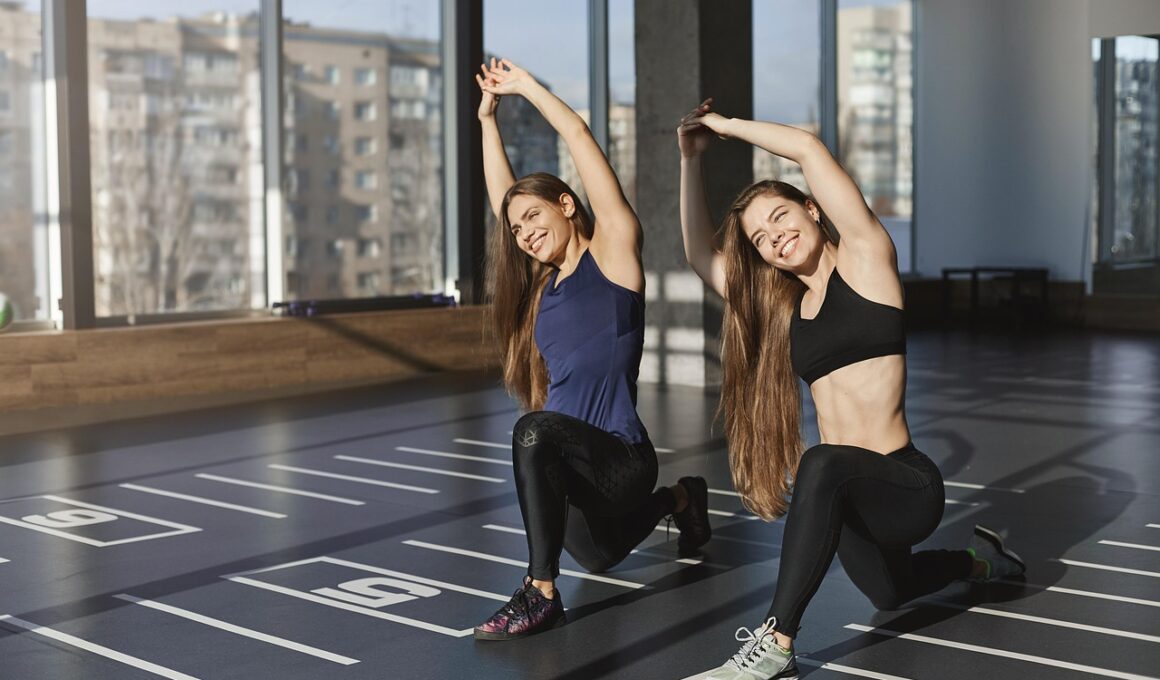Avoiding Common Injuries with Proper Home Workout Techniques
Home workouts have become increasingly popular, offering convenience and flexibility to individuals seeking fitness. To maximize benefits, it’s crucial to adopt proper techniques that minimize the risk of injuries. One common injury is sprains, often caused by improper warm-ups or inadequate stretching. Start every session with dynamic movements to increase blood flow to muscles. Incorporating exercises like leg swings and arm circles will prepare your body for intense activities. Another critical aspect is maintaining proper form during exercises. For instance, when performing squats, ensure that your knees align with your toes to avoid undue strain. Utilize mirrors or video recordings to check your alignment, making adjustments as needed. Additionally, listen to your body’s signals; pain is an indication that something may be wrong. If a specific movement causes discomfort, consider modifying it or seeking guidance from fitness professionals. Gradually increasing intensity and volume also plays a vital role. Avoid rushing into complicated routines; progress slowly to build resilience and strength without overexerting yourself. This approach creates a sustainable workout regimen that enhances overall fitness while minimizing injury risks.
Ensuring a Safe Environment for Home Workouts is essential. Creating a designated workout area allows you to focus better. Clear the space of any hazards such as sharp objects and uneven flooring. Use a non-slip mat to prevent falls during various exercises, particularly during high-impact activities like jumping or dancing. Moreover, appropriate footwear can significantly enhance your stability and support. Opt for shoes designed specifically for your workout type, whether it’s cardio, strength training, or yoga. Ensure that your equipment is in good condition. Regularly inspect weights, resistance bands, and other gear for wear and tear that could lead to accidents. Stay hydrated throughout your routine; dehydration can lead to dizziness and fainting, increasing the likelihood of injury. A water bottle nearby is crucial for quick access during breaks. It’s equally important to have accessible first aid supplies; accidents can happen even in the best-prepared environments. Knowing how to address minor injuries quickly can prevent them from becoming more serious issues. By fostering a safe and efficient workout space, you lay the groundwork for effective and injury-free home workouts.
Understanding Common Injuries in Home Workouts
Additionally, understanding the most common injuries related to home workouts can help in prevention. Strains and sprains are prevalent, especially among those who participate in strength training without proper guidance. For instance, lifting weights using incorrect posture can lead to serious shoulder or back injuries. Learning about muscle groups and joint alignment should be a priority. Another common injury is tendonitis, which develops due to repetitive motions without sufficient rest. Activities like push-ups or running can lead to inflammation in tendons if they are overused. To combat this, implement rest days into your weekly schedule, allowing your body the opportunity to recover. Furthermore, prevent overexertion by knowing your limits. If you are new to exercise, starting with lower weights or decreased intensity can prevent potential injuries. Establishing a balanced routine that includes rest, strength, flexibility, and cardiovascular elements can promote general wellbeing and reduce injury risks. This balanced approach allows all muscle groups to strengthen while avoiding overworking specific areas. Being aware of the types of injuries associated with home workouts equips you with the knowledge to exercise safely and effectively, ensuring a healthy fitness journey.
Now, let’s address some effective home workout techniques to reduce injury risks. Initiating your routine with warm-ups is essential; dynamic stretching can prepare your body both physically and mentally. Performing light cardiovascular activities like jogging in place or jumping jacks can elevate heart rates gradually, making a significant difference in overall performance. Incorporate stretching exercises post-workout to enhance recovery and flexibility. Techniques such as yoga or static stretches can alleviate muscle tension and promote blood flow to fatigued areas. Additionally, prioritizing core strength is vital for supporting your entire body during workouts. Incorporate exercises like planks and bridges into your routine to build a solid core foundation. These exercises boost overall stability and reduce the risk of injuries in other physical activities. Utilize proper breathing techniques; adequate oxygen intake supports better performance and promotes relaxation. Focus on controlled movements to maintain stability and alignment; fast, uncontrolled motions can lead to mishaps. By integrating these techniques into your home workout routine, you can significantly minimize injury risks while maximizing the benefits of physical fitness.
Listening to Your Body: The Key to Injury Prevention
Listening to your body is perhaps one of the most important factors in avoiding injuries during workouts. Everyone’s fitness levels and capabilities differ, making individual responses crucial to understanding limits. Pay attention to how your body reacts to different exercises; if a workout feels uncomfortable, it’s a signal to halt or modify your routine. Recognizing the difference between discomfort and pain can be challenging. Always err on the side of caution by taking breaks if you feel any sharp pains, allowing your body to recover before continuing. Establish a cooldown routine after workouts to aid recovery, including gentle movements and stretches. Monitoring your energy levels throughout your routine can guide you towards maintaining proper intensity; if fatigue sets in, adjust your exercises to avoid overexertion. Additionally, fatigue can lead to compromised form, increasing the risk of injury. Acknowledge small victories; celebrating improvements keeps motivation high for sustained fitness journeys. Tracking progress and sharing experiences can encourage accountability and connection with fitness communities, enhancing the overall enjoyment of exercise while fostering a safer home workout environment.
Furthermore, it’s essential to have a progressive workout plan to enhance safety. Rather than attempting to lift heavy or perform high-intensity workouts right away, set realistic goals based on your current fitness level. Gradually increase the duration and intensity of workouts over weeks or months, allowing your body to adapt. This progression helps prevent injuries related to pushing your body too hard, too quickly. Including cross-training is an effective strategy; incorporating various workout styles prevents muscle imbalances and reduces the risk of overuse injuries. Combining strength training, cardio, and flexibility work provides a comprehensive fitness approach to support overall wellness. Additionally, ensure your workout schedule allows adequate recovery time between intense sessions; overworking can lead to burnout and increase susceptibility to injuries. Incorporate variety into your routine; changing exercises will challenge your muscles depending on the targeted areas and improve overall fitness. This not only enhances engagement but also reduces the likelihood of injuries related to repetitive movements. By following these strategies and embracing a gradual approach, you create a sustainable fitness plan built on safety and health.
Closing Thoughts on Safe Home Workouts
In conclusion, maintaining a focus on injury prevention is essential for achieving sustainable fitness through home workouts. Understanding the common risks, employing proper techniques, and listening to your body can significantly reduce injury chances. Establishing a dedicated workout space enhances safety, while appropriate equipment and footwear further support injury prevention. Incorporate a variety of exercises while allowing time for recovery; these strategies promote a balanced fitness approach that leads to long-term health benefits. Remember, fitness is a journey that requires patience and knowledge; setting realistic goals and celebrating progress keep motivation alive. Seeking professional guidance, whether through online tutorials or personal trainers, can provide personalized insights that contribute to injury-free workouts. Share your experiences within fitness communities for support and encouragement; staying connected can enhance enjoyment and accountability. Embrace this journey while prioritizing safety and wellbeing. As your strength and fitness improve, remember that listening to your body remains key; adjust workouts as needed to ensure continued progress without risking injury. By following these principles, you pave the way for effective and enjoyable home workout experiences.
Overall, focusing on safe exercise practices while enjoying the flexibility of home workouts is imperative. When embarking on this fitness journey, prioritize taking your time and adapting the routines to fit your needs. Individualized workouts, combined with diligent attention to technique and safety, can foster a rewarding experience. As you explore various home workout options, ensure you stay informed and practice consistently. Use resources like reputable fitness websites or apps that offer guidance on exercise variations and safety tips. As you become more experienced, consider expanding your routine to include diverse workout styles that will motivate and challenge your body differently. Monitoring your progress will help you celebrate achievements and overcome hurdles. Always keep the idea of continuous improvement in mind; adapting workouts based on evolving fitness levels provides both safety and effectiveness. Embrace every small success and learn from setbacks, as they contribute to your overall growth. A holistic approach incorporating physical, mental, and emotional health will optimize your home workout experience. Ultimately, by emphasizing safety and awareness, you create a fruitful and enjoyable journey toward better fitness at home.


